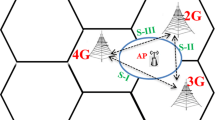Abstract
The require of omnipresent wireless access and high data rate services are expected to increase extensively in the near future. In this context, heterogeneous networks, which are a mixture of different wireless technologies (LTE-advanced, LTE-advanced Pro, C-IoT (Cellular Internet of Thing), 5G WiFi, etc) are invited to enable important capabilities, such as high data rates, low latencies and efficient resource utilization in order to provide dedicated capacity to offices, homes, and urban hotspots. Mixing these technologies in the same system, with their complementary characteristics, to afford a complete coverage to users can cause various challenges such as seamless handover, resource management and call admission control. This article proposes a general radio resource management framework which can be supported by future network architectures. A combined call admission control, resource reservation algorithm and bandwidth adaptation based IEEE 802.21 MIH standard approach for heterogeneous wireless network is detailed in this framework. Our aims are to guarantee quality of service (QoS) requirements of all accepted calls, reduce new call blocking probability and handover call dropping probability, and maintain efficient resource utilization. Performance analysis shows that our proposed approach best guarantees QoS requirements.











Similar content being viewed by others
Explore related subjects
Discover the latest articles, news and stories from top researchers in related subjects.References
Zarai, F., Ali, K. B., Obaidat, M. S., & Kamoun, L. (2012). Adaptive call admission control in 3GPP LTE networks. International Journal of Communication Systems, 25(12), 1–13.
Kim, Y., Pack, S, & Lee, W. (2010). Mobility-aware call admission control algorithm in vehicular WiFi networks. In IEEE Global Telecommunications Conference (GLOBECOM), Florida, (pp. 1–5).
Omheni, N., Gharsallah, A., Zarai, F., Obaidat, M. S. (2014). Control, call admission, approach, adaptive bandwidth management approach for HWNs. In IEEE Global Communications conference (GLOBECOM), USA: Texas (pp. 112–117).
Kokila, S., Shankar, R., & Dananjayan, P. (2012). Performance analysis of dual threshold call admission control in 3G/WLAN coupled network. In IEEE-International Conference on Advances in Engineering, Science And Management (ICAESM), Tamil Nadu (pp. 404–409).
Chen, G., & Shen, L. (2012). An adaptive bandwidth allocation algorithm based on the multi-thresholds in heterogeneous wireless network. In IEEE Second International Conference on Consumer Electronics (ICCE), Berlin (pp. 190–194).
Falowo, O. E., & Chan, H. A. (2007). Adaptive bandwidth management andjoint call admission control to enhance system utilization and QoS in heterogeneous wireless networks. Eurasip Journal on Wireless Communications and Networking, 3(2), 1–11.
Antonopoulos, A., & Verikoukis, C. (2010). Traffic-aware connection admission control scheme for broadband mobile systems. IEEE Communications Letters, 14(8), 719–721.
Sabbagh, A. A. L. (2011). A Markov chain model for load-balancing based and service based RAT selection algorithms in heterogeneous networks. International Journal of Mathematical, Computational, Physical, Electrical and Computer Engineering, 5(1), 119–125.
Chang, B. J., Liang, Y. H., Chang, P. Y., & Chen, C. T. (2012). Cost-based CAC with media independent handover for wireless heterogeneous networks. World Telecommunications Congress (WTC), Miyazaki (pp. 1–6).
Ben Ali, K., Zarai, F., & Obaidat, M. S., KAMOUN, L. (2013). Qos scheme based IEEE 802.21 MIH in heterogeneous wireless networks (HWNS). In 6 th International Conference on Information Technology (ICIT), (pp. 1–11), Jordan.
Shih, C. H., Kuo, J. L., Ho, C. Y., & Chen, Y. C. (2012). Media-independent handover design for seamless mobility in heterogeneous WiMAX/Wi-Fi networks. IEEE Transactions Communications, E95–B(10), 3168–3178.
Ali, M., Pillai, P., & Hu, Y. F. (2012). Load-aware radio access selection in future generation satellite-terrestrial wireless networks. International Journal of Wireless Mobile Networks, 4(1), 35–54.
ZHANG, Y. Y., XIAO, C., & WANG, J. (2016). An optimal joint call admission control policy in heterogeneous wireless networks. International Journal of Future Generation Communication and Networking, 9(1), 207–222.
Glaucio, H. S. Carvalho, Woungang, I., & Anpalagan, A. (2013). A semi-Markov decision process-based joint call admission control for inter-RAT cell re-selection in next generation wireless networks. International Journal of Computer Networks, 57(2), 3545–3562.
Pan, J., & Zhang, W. Y. (2014). Energy efficieny priority admission control and service transfer algorithm based on Markov decision processes in hierarchical networks. International Journal of university of science and technology of CHINA, 44(2), 138–146.
Khan, S., Ahmed, A., Ullah, I., & Zubair, S. M. (2016). Call admission control based femtocell handover in LTE networks. In International Conference on Computing, Electronic and Electrical Engineering (ICE Cube) (pp. 196–201).
Yi, L. Y., Shariff, A. R., & Zaini, K. M. (2015). User behavior based call admission control for traffic steering in Wi-Fi/cellular networks. Advanced computer and communication engineering technology, Lecture Notes in Electrical Engineering, (Vol. 362, pp. 407–417).
Lim, W. S., Kim, D. W., Suh, Y. J., & Won, J. J. (2009). Implementation and performance study of IEEE 802.21 in integrated IEEE 802.11/802.16e networks. International Journal of Computer Communications, 32(1), 134–143.
Michalas, A., Sgora, A., & Vergados, D. D. (2017). An integrated MIH-FPMIPv6 mobility management approach for evolved-packet system architectures. International Journal of Network and Computer Applications. doi:10.1016/j.jnca.2017.02.003.
Ahmad, I., et al. (2016). New Concepts for Traffic, Resource and Mobility Management in Software-Defined Mobile Networks. https://www.researchgate.net/publication/291814024.
Angoma, B. (2012). A vertical handover implementation in a real test bed. International Journal of Mobile Computing, 1(1), 1–14.
3GPP TR 23.720. Study on architecture enhancements for Cellular Internet of Things, Release 13. (2016-03)
Omheni, N., Zarai, F., Obaidat, M. S., Hsiao, K. F., & Kamoun, L. (2014). A novel MIH-based approach for vertical handover over heterogeneous wireless networks. International Journal of Communication Systems, 27(5), 811–824.
IETF, RFC 2386. A Framework for QoS-based Routing in the Internet. http://www.rfc-base.org/txt/rfc-2386.txt.
Author information
Authors and Affiliations
Corresponding author
Rights and permissions
About this article
Cite this article
Omheni, N., Gharsallah, A. & Zarai, F. An enhanced radio resource management based MIH policies in heterogeneous wireless networks. Telecommun Syst 67, 577–592 (2018). https://doi.org/10.1007/s11235-017-0358-4
Published:
Issue Date:
DOI: https://doi.org/10.1007/s11235-017-0358-4




